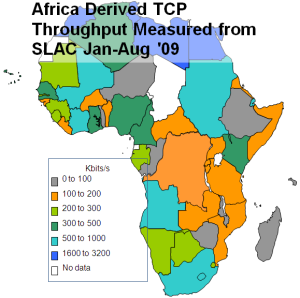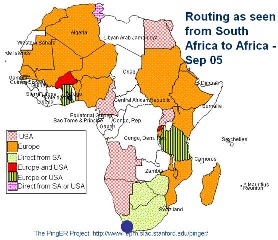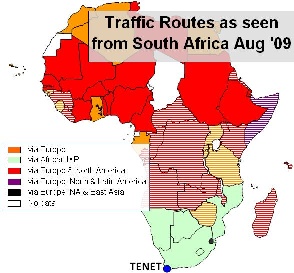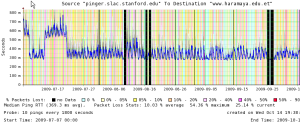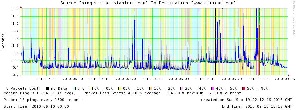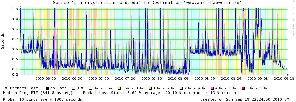...
<ac:structured-macro ac:name="unmigrated-wiki-markup" ac:schema-version="1" ac:macro-id="978aa8d9b6ac5b07-699869d1-454949b3-9cb78db8-bda2fdb3d2f7cd6bc2085754"><ac:plain-text-body><![CDATA[ | Derived Throughput from SLAC to Africa Jan-Aug '09 [[xlsx | ^africa-thru-aug09.xlsx]] | MinRTT from SLAC - Aug. 2009 [[xls | ^map-africa-minrtt-aug2009.xls]] | ]]></ac:plain-text-body></ac:structured-macro> | |
|---|---|---|---|---|---|---|
|
|
...
<ac:structured-macro ac:name="unmigrated-wiki-markup" ac:schema-version="1" ac:macro-id="7ba229dd65e72b3a-baeaef15-438c4750-b7bab4c9-44dae5680ca4090f75f1e8d4"><ac:plain-text-body><![CDATA[ | Routing from South Africa to African Countries (Sep '05) | Routing from South Africa to African Countries (Aug '09) [[xls | ^routing-africa-aug2009.xls]] | Routing from Burkina Faso to African Countries (Aug '09) [[xls | ^routing-africa-aug2009.xls]] | ]]></ac:plain-text-body></ac:structured-macro> |
|---|---|---|---|---|---|---|
| |
|
...
I googled MORENET Mozambique and came up with morenet.mct.gov.mz. However it does not respond to pings. It does respond to synack on port 80 (www) and the response time to a trivial request is ~368ms so it may have already moved over. However GeoIPTool (see http://www.geoiptool.com/en/?IP=morenet.mct.gov.mz) says it's in Buenos Aires which I do not believe. Visualroute's (at http://visualroute.visualware.com/) tests fail. Looking at the traceroute from SLAC and using GeoIPTool to locate the nodes , it appears that on leaving the US the route goes directly from the West Coast of the US (Sunnyvale) through Buenos Aires (node telkomsa.ge9-16.br02.ldn01.pccwbtn.net 152ms) then to Pretoria (rrba-ip-lir-1-pos-1-0-4.telkom-ipnet.co.za 352 ms) and then to Mozambique. This it is not currently using the new fibreoptic fibre optic cable running South down the E. African coast. Looking at a map of the world's undersea fibre cables in the region may help explain this.
...
One host (www.aisha.ac.zm) of the 6 monitored in Zambia improved its RTT from about 720ms to 550ms on August 20, 2009 (see below). THey then spent many days moving the link over to the terrestrial lines. During this time the performance was very unstable (high losses) and there were big changes in RTT. It is probable the link in one direction was using a GEOS while the other was an all terrestrial link and the large dips to 400ms were when both legs were using terrestrial links. We believe the terrestrial path goes via Botswana and Namibia. The traceroute from SLAC on 9/9/09 appeared to use a satellite link in at least one direction. The final cutover to terrestrial linkis in both directions appears to have been made on October 23rd when the RTT drpped dropped to ~350ms and the link appeared more stable. On October 2, 2009 Mike Jensen reported that thetraceroute from Rome to www.aisha.ac.zm on Oct 2, 2009 from Rome New E. Coast of Africa Fibre was well below 450ms and thus appears to be a terrestrial link. However the tracreoute from SLAC was still taking over 550ms. Also thetraceroute from TENET/Cape Town South Africa to www.aisha.ac.zm took over 650ms. The The traceroute from NUST, Islamabad, Pakistan to mail.unza.zm New E. Coast of Africa Fibre takes less than 450ms and appears to be a terrestrial path going via Namibia. On October 7th 2009 the traceroute from SLAC to mail.unza.zzm appeared to be terrestrial and went via Namibia.
Angola: www.novagest.co.ao | Ethiopia: www.haramaya.edu.et | Namibia: www.adsl.com.na | |
|---|---|---|---|
| |
| |
Zambia: www.aisha.ac.zm |
|
| |
| |
|
Zimbabwe
There is some evidence that at least one host in Zimbabwe (www.africau.edu) may have activated a terrestrial route around June 18th 2010, see the graph below. Around that date the RTT dropped from 550 ms to about 400ms, however it went up again around August 12th 2010. Similar results are seen for a second Zimbabwean host www.aazimbabwe.co.zw, suggesting a common access route between them and SLAC.
...
